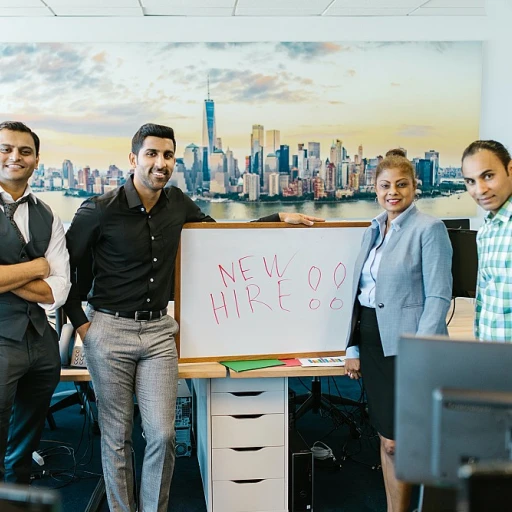Forming: The Foundation of Team Dynamics
Establishing the Groundwork of Team Dynamics
The journey to understanding employee engagement begins at the forming stage of team development. Here, team members are first introduced, and the foundation for future group dynamics is laid. It's vital to recognize the forming stage as an essential time for setting expectations and establishing relationships within the team. As team members become acquainted with one another, they seek to understand the group's purpose and the goals they are collectively working towards.
At this stage, the role of the leader is critical. The leader must facilitate introductions, explain the project objectives clearly, and cultivate an environment of open communication to help team members acclimate. It is during this phase that members often rely heavily on the leader for guidance and assurance.
While the forming stage might appear as a simple phase of introductions and getting-to-know-you exercises, it is, in fact, a strategic phase that requires careful management. Setting a solid foundation here ensures teams will navigate subsequent stages, like storming and norming, more effectively. For more guidance on fostering a productive team environment from the start, explore our insights on enhancing employee engagement through effective team meetings.
For leaders and project managers, understanding the significance of this stage can also aid in recognizing potential issues early and addressing them before they evolve into larger challenges. Building trust, establishing clear goals, and fostering a sense of inclusion can have profound impacts on how the team functions at this initial stage and onwards.
Storming: Navigating Conflicts and Challenges
Addressing Tensions for Effective Collaboration
The storming stage in team development marks a critical point where conflicts and challenges often surface. This stage is essential, albeit turbulent, as it lays the groundwork for deeper understanding and cohesion within the team. During storming, team members may experience heightened tension as they navigate differing opinions, work styles, and personalities. However, it’s through these challenges that growth occurs.
Faced with a complex project or a challenging task, team members begin to express their individual viewpoints more openly. This openness can sometimes lead to clashes as the group strives to find a unified direction. These conflicts are natural, but the manner in which they are managed can significantly impact the team's development. An effective leader plays a crucial role in guiding the team through this stage. By fostering open communication and actively addressing any issues that arise, a leader can help the team move from storming to norming.
Role of the Leader
An adept leader will tactfully address conflicts, acknowledging the contributions of all team members while steering discussions productively. By encouraging transparency and mutual respect, leaders can facilitate an environment where team members feel heard and valued. This sets the stage for the smooth transition to the next phase of development—norming.
Fostering a Supportive Environment
- Facilitate Open Dialogue: Encourage dialogues where team members can voice their concerns without fear of repercussion, enabling a more cohesive group dynamic.
- Set Clear Expectations: Clearly define roles and responsibilities to mitigate misunderstandings and direct the team’s focus on the collective goal.
- Encourage Collaboration: Create opportunities for members to work together in varying group combinations to build trust and understanding.
Leaders and team members alike must navigate these stormy waters with patience and understanding. Successfully emerging from the storming stage equips teams with improved communication skills and established trust, leading to more effective collaboration. To delve deeper into navigating these phases of team development, consider exploring strategies for enhanced team dynamics.
Norming: Building Cohesion and Unity
Fostering Unity and Cooperation
As teams transition through the stages of development, the importance of establishing strong group dynamics becomes especially evident. Within this phase, members begin to shift from a storming to what is often referred to as a 'norming stage.' In this critical stage of group development, the emphasis is largely on fostering unity and building the synergy necessary for achieving shared goals. During this period, teams typically experience a sense of cohesion and mutual respect among their members. The previous conflicts and challenges encountered in the storming stage serve as a foundation for a more profound understanding of each other's strengths and weaknesses, ultimately leading to improved collaboration. Key characteristics of this stage include:- Clarified roles: Team members gain clarity on their roles and responsibilities, which reduces misunderstandings and overlaps in tasks. This clarity contributes to a more harmonious work environment.
- Established norms: Groups establish working norms and procedures, ensuring that everyone is aligned with the team's objectives and processes, promoting consistency in their workflow.
- Open communication: A culture of open communication is fostered, where team members feel comfortable sharing ideas and feedback. This ultimately leads to more innovative and effective problem-solving.
- Increased trust: As cohesiveness strengthens, trust-building becomes a natural result. Trust among team members encourages a positive atmosphere conducive to high performance.
Performing: Achieving Peak Team Performance
Driving Excellence in the Performing Phase
The performing stage symbolizes the zenith of team development, where the team has evolved from its prior challenges and established a seamless workflow. At this juncture, teams are high performing, demonstrating well-coordinated efforts, and maintaining clarity in their roles and responsibilities. The group members work with mutual trust and respect, allowing effective problem-solving and innovation to flourish.
During this performing stage, team members exhibit a profound understanding of the group's vision and are adept at capitalizing on each other’s strengths. Communication within the team is optimized, not just in frequency but in quality. These well-engaged teams have the potential to drive outstanding project outcomes, given their adeptness at navigating complex tasks without significant oversight.
However, the work doesn't stop here for leaders. They must remain vigilant, guiding their team while still allowing space for autonomy. Providing continuous opportunities for professional growth and recognizing achievements reinforces a sense of belonging and motivates team members to maintain their high performance.
Some strategies to foster sustained engagement in this stage include:
- Recognition and Rewards: Implementing an effective system for acknowledging individual and team accomplishments strengthens motivation.
- Autonomous Work Environment: Encourage team members to take initiative, empowering them to execute tasks with minimal supervision.
- Opportunities for Advancement: Continuously identify skill development opportunities that align with the team's goals and aspirations.
- Regular Feedback: Maintain an open channel for feedback to reinforce positive outcomes and address areas that require improvement.
In conclusion, reaching the performing phase showcases the culmination of previous stages. Yet, the dynamic nature of teams necessitates ongoing attention and nurturing to sustain this peak level of performance. This commitment not only boosts team morale but also reinforces the cyclical essence of Tuckman's group development model.
Adjourning: Reflecting on Achievements and Transitions
Reflecting on Achievements and Transitions
As teams complete their projects and move towards the adjourning stage, it's imperative to consider the importance of reflecting on achievements. This stage brings closure to the group development process, providing an opportunity for team members to look back on their journey through the various stages team have experienced.
Taking time to acknowledge the efforts and contributions of individual team members and the group as a whole enhances team spirit and provides a sense of accomplishment. The process of reflection should be comprehensive, involving feedback sessions and discussions that cover the entire development cycle from forming, storming, and norming to the high performing stage. These discussions foster a sense of closure, acknowledging both successes and areas for improvement.
Moreover, adjourning is an essential phase to facilitate the transition from one project or team assignment to the next. Leaders should emphasize the achievements and improvements made, while also considering individual career advancements and personal growth gained during the process. This not only helps team members transition smoothly to new roles but also strengthens future collaboration and employee engagement across the organization.
In conclusion, purposeful reflection during the adjourning stage goes a long way in reinforcing team members' commitment to teamwork and engenders lasting positive morale. By recognizing the strides made through each stage of development, organizations can ensure that the process culminates in a fulfilling conclusion, readying teams for future challenges.
Strategies to Enhance Employee Engagement Throughout Team Development
Strengthening Engagement Across the Development Stages
In each phase of team development, there are strategies leaders can employ to enhance employee engagement. Understanding the nuances of each stage and aligning your approach can significantly increase team motivation, coherence, and productivity.
- Emphasize the Foundation: During the initial stages such as forming, team leaders should focus on creating a welcoming environment. Encouraging open communication and providing clear objectives can aid team members in understanding their roles and responsibilities, setting a solid ground for engagement.
- Navigate Challenges with Empathy: The storming stage is known for its challenges. Active listening and conflict resolution skills are critical as team members navigate this period of potential discord. Leaders should facilitate discussions that allow team members to express their concerns and collaboratively find solutions, strengthening team dynamics and engagement.
- Foster Unity and Cohesion: As the team moves into the norming stage, leaders should promote activities that build trust and unity among group members. Recognizing achievements, both individual and collective, reinforces the positive aspects of teamwork and keeps the momentum toward engagement.
- Encourage High Performance: In the performing stage, when the team is operating at peak efficiency, it's essential to maintain motivation through support and recognition. Offer professional development opportunities and encourage team members to set personal and group goals, fostering a continuous growth mindset.
- Reflect and Celebrate Success: As teams transition into the adjourning stage, reflection becomes crucial. Take the time to review what has been achieved and the individual contributions within the group. Celebrating these milestones not only boosts morale but reinforces a culture of appreciation and achievement.
By thoughtfully engaging with team members throughout the various stages of development, leaders can cultivate a motivated and cohesive work environment. This ongoing commitment to fostering a supportive group dynamic ultimately leads to sustained employee engagement.












